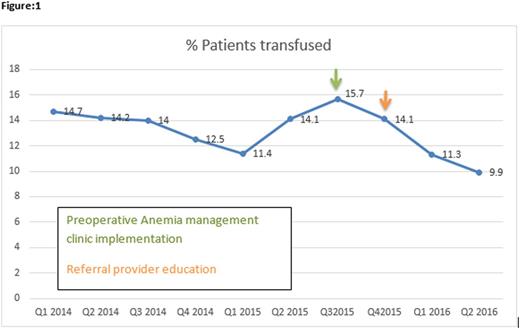Abstract
Background:
Preoperative anemia is commonly encountered with a reported incidence of 5-75% in elective presurgical populations. Anemia is an independent risk factor for perioperative morbidity and mortality and is a strong predictor of perioperative blood transfusion. Approximately 50% of all blood transfusions occur in the perioperative setting and transfusions are a significant financial burden for healthcare institutions. Although preoperative anemia management has been shown to reduce transfusion requirements and improve perioperative outcomes, the optimal delivery model for this service remains unclear. We describe the implementation of a novel preoperative anemia management clinic (AMC) workflow and report patient volume trends since its implementation in Jan 2015 at the University Of Iowa Hospitals & Clinics.
Methods:
We identified patients undergoing elective high blood loss (HBL) surgical procedures (defined as predicted blood loss >500 cc) with a preoperative hemoglobin (Hb) <12 g/dl as the target population for preoperative anemia management. We identified HBL procedures by ICD codes using information derived from our institutional maximum surgical blood-ordering schedule (MSBOS), intraoperative estimated blood loss (EBL) data from the electronic medical record (EMR) and surgical provider input. In calendar year 2014, 3262 elective HBL surgical patients were identified, out of which 452 (13.9%) received perioperative red cell transfusions. 232 (51.3%) of these patients had a preoperative Hb <12 g/dl. 61 (26%) of these patients were transfused 1 unit PRBCs, 62 (27%) were transfused 2 units and the remaining 109 (47%) patients were transfused > 2 units. Assuming 1- 2 unit transfusions were preventable by preoperative anemia managment, the calculated cost savings to the institution by avoiding these transfusions was estimated to be $200,000/year, not including potential improvement in length of stay. Using these data as baseline, a business plan for an AMC was presented to and approved by our hospital administration. An outpatient clinic was initiated in a temporaray location in early 2015 and later moved to a permanent location with infusion capabilities in August 2015 with two full time staff including a nurse practitioner and a medical assistant supervised by a nurse manager and a medical director. To streamline workflow, a stepwise algorithm for diagnosis and management of anemia was created by a multidisciplinary team that included Hematology, Anesthesiology, Surgery, Internal Medicine, Nursing and Pharmacy. We established referral mechanisms primarily from surgical clinics via automatic EMR alerts for elective HBL procedures linked to case scheduling through the EMR and secondarily through direct outpatient consultations.
Results:
We observed an overall trend of reduction in the percentage of patients transfused perioperatively in the two quarters following implementation of the preoperative AMC compared with the preceding quarterly intervals since Jan 2014 (Figure). In the same time period we observed a steady increase in number of patient visits to the AMC and number of iron infusions administered. Patient visits and iron infusions more than doubled in the first two quarters of 2016 compared to same time period in 2015 (594 vs 195 and 366 vs 124 respectively). There was a significant reduction in average length of stay (2.78 days) for patients who received transfusions after an AMC visit compared with patients who were not seen in the AMC.
Conclusions:
Implementation of a structured preoperative anemia management clinic (AMC) with an automatic referral workflow is feasible at a large academic medical center and appears to result in reductions in blood transfusions and hospital length of stay. The heterogeneity of our surgical population and the short timespan since implementation of the AMC are limitations of this analysis. We have ongoing efforts to minimize system errors in our referral mechanisms (ie appropriate EMR alerts to surgeons) and enhance surgical provider education to maximize preoperative anemia management opportunities.
No relevant conflicts of interest to declare.
Author notes
Asterisk with author names denotes non-ASH members.


This feature is available to Subscribers Only
Sign In or Create an Account Close Modal